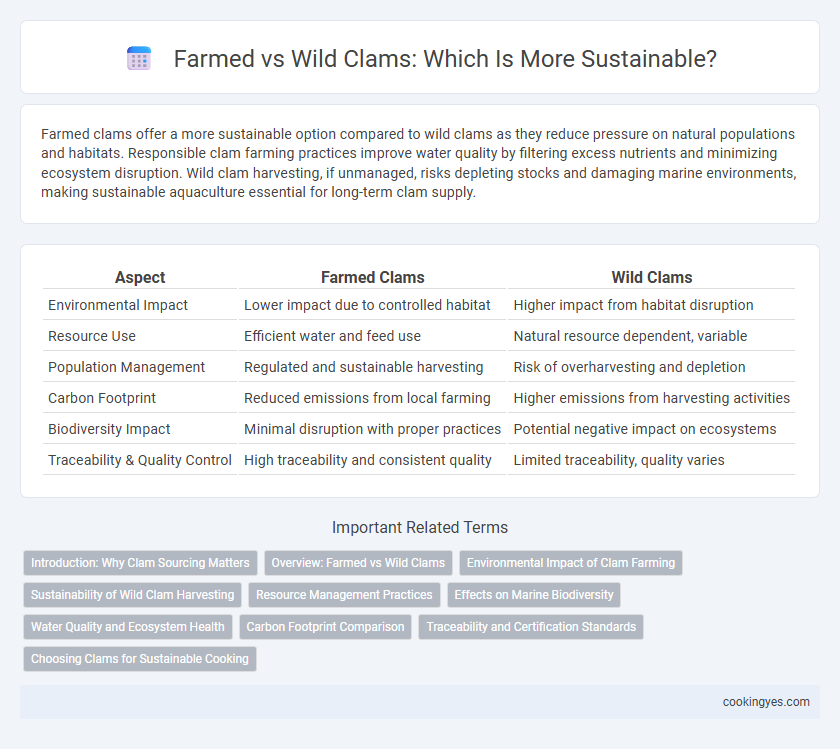Farmed clams offer a more sustainable option compared to wild clams as they reduce pressure on natural populations and habitats. Responsible clam farming practices improve water quality by filtering excess nutrients and minimizing ecosystem disruption. Wild clam harvesting, if unmanaged, risks depleting stocks and damaging marine environments, making sustainable aquaculture essential for long-term clam supply.
Table of Comparison
| Aspect | Farmed Clams | Wild Clams |
|---|---|---|
| Environmental Impact | Lower impact due to controlled habitat | Higher impact from habitat disruption |
| Resource Use | Efficient water and feed use | Natural resource dependent, variable |
| Population Management | Regulated and sustainable harvesting | Risk of overharvesting and depletion |
| Carbon Footprint | Reduced emissions from local farming | Higher emissions from harvesting activities |
| Biodiversity Impact | Minimal disruption with proper practices | Potential negative impact on ecosystems |
| Traceability & Quality Control | High traceability and consistent quality | Limited traceability, quality varies |
Introduction: Why Clam Sourcing Matters
Clam sourcing plays a critical role in sustainable seafood practices due to its impact on marine ecosystems and local economies. Farmed clams reduce pressure on wild populations, helping preserve biodiversity and maintain ecological balance. Sustainable clam farming also supports water quality improvement by filtering excess nutrients, making it an eco-friendly alternative to wild harvesting.
Overview: Farmed vs Wild Clams
Farmed clams offer a sustainable seafood option by reducing pressure on wild populations and promoting ecosystem balance through controlled aquaculture practices. Wild clams, while naturally harvested, face challenges from overfishing and habitat degradation, impacting their long-term availability. Sustainable clam farming integrates environmental stewardship with economic benefits, ensuring a reliable supply while preserving marine biodiversity.
Environmental Impact of Clam Farming
Clam farming offers a more sustainable alternative to wild clam harvesting by reducing habitat destruction and maintaining biodiversity in coastal ecosystems. Farmed clams improve water quality through their natural filtration process, which helps mitigate eutrophication and supports marine life. Controlled aquaculture practices minimize overfishing pressures on wild populations, conserving natural clam habitats while meeting commercial demand.
Sustainability of Wild Clam Harvesting
Wild clam harvesting supports marine biodiversity by maintaining natural population dynamics and reducing habitat disruption compared to intensive farming. Sustainable practices such as regulated harvesting seasons, size limits, and habitat protection ensure clam populations remain stable without depleting natural stocks. This approach minimizes environmental impacts, preserving ecosystem balance and enhancing long-term resource availability.
Resource Management Practices
Farmed clams utilize controlled aquaculture methods that reduce habitat disturbance and minimize resource depletion, promoting sustainable seafood production. Wild clam harvesting requires strict regulation of harvesting seasons and quotas to prevent overexploitation and maintain ecosystem balance. Effective resource management in both farming and wild practices ensures long-term viability of clam populations and supports marine biodiversity conservation.
Effects on Marine Biodiversity
Farmed clams provide a controlled environment that reduces overharvesting pressure on wild populations, thereby helping to preserve marine biodiversity. In contrast, wild clam harvesting can disrupt benthic ecosystems due to dredging or digging, negatively impacting habitat complexity and non-target species. Sustainable clam farming practices contribute to maintaining ecological balance by minimizing habitat destruction and supporting marine biodiversity conservation.
Water Quality and Ecosystem Health
Farmed clams contribute to improved water quality by filtering large volumes of water, reducing excess nutrients and promoting clearer, healthier marine environments. Wild clam harvesting, if unmanaged, can disrupt benthic habitats and negatively impact ecosystem health by disturbing sediment and associated species. Sustainable clam farming practices support biodiversity and ecosystem balance, making them a preferable option for long-term environmental sustainability.
Carbon Footprint Comparison
Farmed clams generally exhibit a lower carbon footprint compared to wild clams due to controlled environments that reduce energy-intensive harvesting methods. Wild clam harvesting often involves fuel-consuming equipment and habitat disturbances, increasing greenhouse gas emissions. Sustainable clam aquaculture supports carbon sequestration by maintaining sediment quality, further enhancing its environmental benefits.
Traceability and Certification Standards
Farmed clams benefit from rigorous traceability systems and certification standards such as ASC (Aquaculture Stewardship Council) and MSC (Marine Stewardship Council), ensuring sustainable practices and minimizing environmental impact. Wild clams, while often perceived as more natural, face challenges in traceability due to variable harvesting locations and lack of consistent certification, leading to potential overfishing and habitat degradation risks. Certification and traceability are critical in promoting sustainable clam consumption by providing transparency and accountability throughout the supply chain.
Choosing Clams for Sustainable Cooking
Farmed clams offer a more sustainable option compared to wild clams, as they are cultivated in controlled environments that minimize habitat disruption and overharvesting. Wild clams, while natural, often face population depletion due to excessive dredging and environmental pressures. Selecting farmed clams supports sustainable seafood practices by promoting responsible aquaculture that maintains ecological balance and reduces the carbon footprint associated with clam harvesting.
Farmed vs Wild for sustainability Infographic

 cookingyes.com
cookingyes.com